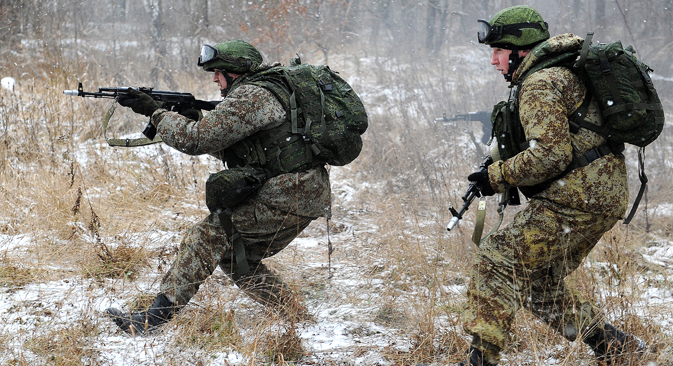
Russian soldiers using the Ratnik (Warrior) equipment. Source: RIA Novosti
The Russian Advanced Research Projects Foundation and the Saratov State University have created a joint Special-Purpose Materials Laboratory and are working on developing advanced materials for combat equipment.
Russian line troops have already been issued the first equipment from the “soldier of the future” complex – the Ratnik (Warrior), which is composed of many elements, including modern fabrics and lightweight composite protective devices. However, as RIR learned from the Advanced Research Projects Foundation, the existing equipment complex does not guarantee the required level of safety and comfort for a soldier, so it is necessary to create fundamentally new means of protection and life-support.
One of the technological bases for the new materials is the principle of obtaining ultrafine fibers using electrospinning. Using this technology, it is possible to obtain superfine synthetic fibrous material with unique protective properties.
Work is being done in three directions: Masking, Protection, and Life-Support.
In the “masking” direction, Saratov scientists are creating advanced materials, which, according to Sergey Lisovsky, Minister of Industry and Energy of the Saratov Oblast, will allow producing fabrics with a wide range of coating properties – from impact proof materials to those invisible in a certain radiation spectrum. The Ratnik system also boasts similar features: its suit of armour blocks radiation in the ultraviolet and infrared spectra, which makes the soldier invisible to thermal sensors. Nevertheless, in the future outfits, being designed today, these properties will be strengthened.
In other words, in a few years the military will get “invisibility cloaks”. Thanks to their fibrous structure, these materials will be lightweight and have “breathable” properties, which means that these outfits can be worn by the military at all times. Today, the “breathable” construction of the new Ratnik equipment provides the possibility of continuous wear for about 48 hours.
These materials have already been demonstrated to Russian President Vladimir Putin during his January visit to training grounds of the Central Research Institute of Precision Engineering (TSNIITOCHMASH). “At the exhibition, we conducted real live tests that demonstrate the properties of the materials developed in the laboratory,” said Alexey Serdobintsev, researcher at the Special-Purpose Materials Laboratory. “The president did not comment on any of the projects, but according to colleagues from the Foundation, our demonstration had made a positive impression on him,” he said.
Materials developed by the ARP Foundation and Saratov University in the Zashchita (Protection) sphere are designed to withstand damage from weapons fire and protect the skin and respiratory system from the effects of weapons. According to their protective properties, these materials will surpass those already in use today. For example, the continuous wearing of modern military gas masks cannot exceed four hours. “The filtration systems created in the laboratory will significantly increase this time, not impeding breathing while maintaining its protective properties,” RIR learned from the ARP Foundation’s representative.
The developers of advanced materials, which will be used to create equipment of a new generation, are actively adapting them to extreme conditions. According to the ARP Foundation, these materials will withstand open flames, the exhausting heat of a desert, and fierce arctic cold. The equipment in service today is not designed for such extremes.
Russian developments in the field of equipment for the “soldier of the future” – designed to make the line soldier into a full-fledged combat unit along with artillery, aviation and other technologies used in the field – have been conducted since the early 2000s. According to Andrey Grigoriev, general director of the ARP Foundation, an improved version of the Ratnik complex is planned for introduction between 2025-2030.
All rights reserved by Rossiyskaya Gazeta.
Subscribe
to our newsletter!
Get the week's best stories straight to your inbox